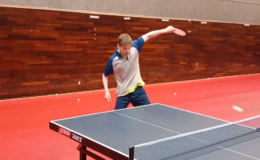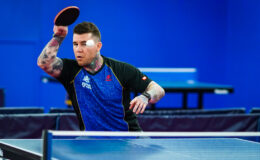 By Larry Hodges, USATT Hall of Famer and Certified National Coach
By Larry Hodges, USATT Hall of Famer and Certified National Coach
Backswing, forward swing . . . backswing, forward swing . . . backswing, forward swing . . . when hitting forehand to forehand or backhand to backhand, how many of you get into this pattern, whether hitting or looping? The problem is you are doing something you should never do in a match, so why would you want to practice it? There are three parts to a swing: Backswing, forward swing, and the often forgotten return to ready position. A player would almost never go directly from his follow through to backswinging.
Beginners and even relatively advanced players often warm up and practice as if there were only two parts to the swing, and it often costs them when it becomes habit. Often in real rallies they are set only for forehand or backhand, not both, because of this lack of return to ready position. If they don’t do it in practice, why would they do it in a match? In reality, these players do tend to sort of return to ready after each shot, but either more slowly or not all the way, and so they often aren’t ready for the next shot. For example, they’ll hit or loop a backhand, and automatically bring their racket back after the follow through as if they were going to play another backhand, when of course they might be playing a forehand. And vice versa for forehands.
Instead, make a practice of returning to ready after each shot when practicing. On both forehands and backhands, this basically means the racket goes through a triangle, starting from the ready position: Backswing (bring racket back); forward swing (bring racket forward and up), and return to ready position (racket drops down and back to where it started, ready for the next shot). Usually these are essentially continuous, so there might not be any stop at the ready position; you go straight through the triangle, with the move to the ready position essentially the first half of the backswing, though it could continue into a backswing for either forehand or backhand. So drop the linear strokes and learn the triangle!



